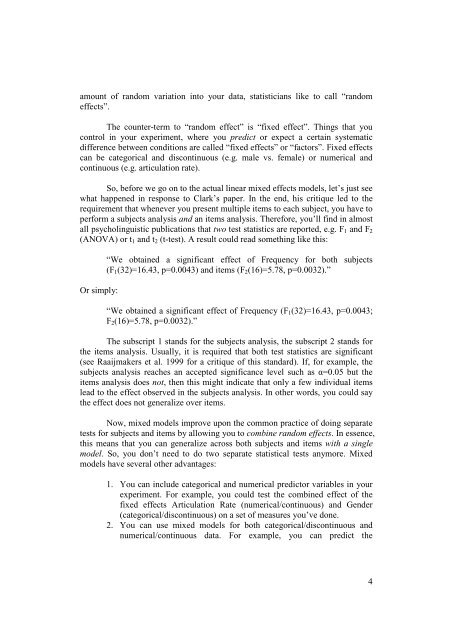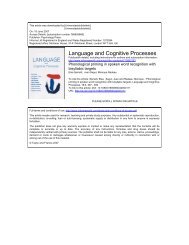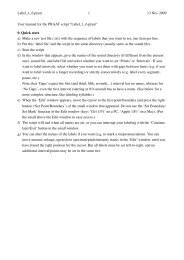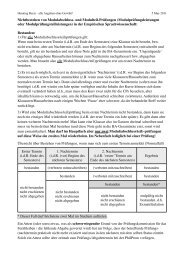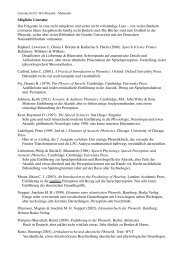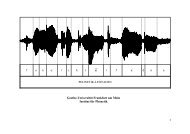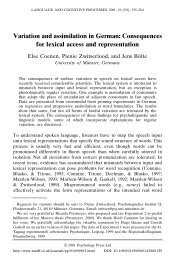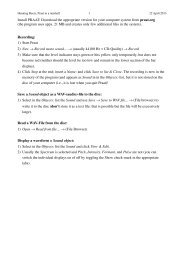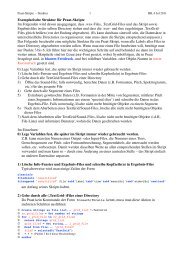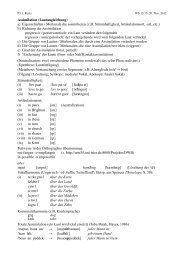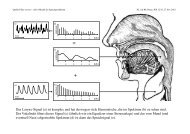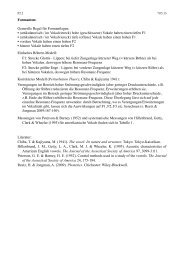A very basic tutorial for performing linear mixed
A very basic tutorial for performing linear mixed
A very basic tutorial for performing linear mixed
You also want an ePaper? Increase the reach of your titles
YUMPU automatically turns print PDFs into web optimized ePapers that Google loves.
amount of random variation into your data, statisticians like to call “random<br />
effects”.<br />
The counter-term to “random effect” is “fixed effect”. Things that you<br />
control in your experiment, where you predict or expect a certain systematic<br />
difference between conditions are called “fixed effects” or “factors”. Fixed effects<br />
can be categorical and discontinuous (e.g. male vs. female) or numerical and<br />
continuous (e.g. articulation rate).<br />
So, be<strong>for</strong>e we go on to the actual <strong>linear</strong> <strong>mixed</strong> effects models, let’s just see<br />
what happened in response to Clark’s paper. In the end, his critique led to the<br />
requirement that whenever you present multiple items to each subject, you have to<br />
per<strong>for</strong>m a subjects analysis and an items analysis. There<strong>for</strong>e, you’ll find in almost<br />
all psycholinguistic publications that two test statistics are reported, e.g. F1 and F2<br />
(ANOVA) or t1 and t2 (t-test). A result could read something like this:<br />
Or simply:<br />
“We obtained a significant effect of Frequency <strong>for</strong> both subjects<br />
(F1(32)=16.43, p=0.0043) and items (F2(16)=5.78, p=0.0032).”<br />
“We obtained a significant effect of Frequency (F1(32)=16.43, p=0.0043;<br />
F2(16)=5.78, p=0.0032).”<br />
The subscript 1 stands <strong>for</strong> the subjects analysis, the subscript 2 stands <strong>for</strong><br />
the items analysis. Usually, it is required that both test statistics are significant<br />
(see Raaijmakers et al. 1999 <strong>for</strong> a critique of this standard). If, <strong>for</strong> example, the<br />
subjects analysis reaches an accepted significance level such as α=0.05 but the<br />
items analysis does not, then this might indicate that only a few individual items<br />
lead to the effect observed in the subjects analysis. In other words, you could say<br />
the effect does not generalize over items.<br />
Now, <strong>mixed</strong> models improve upon the common practice of doing separate<br />
tests <strong>for</strong> subjects and items by allowing you to combine random effects. In essence,<br />
this means that you can generalize across both subjects and items with a single<br />
model. So, you don’t need to do two separate statistical tests anymore. Mixed<br />
models have several other advantages:<br />
1. You can include categorical and numerical predictor variables in your<br />
experiment. For example, you could test the combined effect of the<br />
fixed effects Articulation Rate (numerical/continuous) and Gender<br />
(categorical/discontinuous) on a set of measures you’ve done.<br />
2. You can use <strong>mixed</strong> models <strong>for</strong> both categorical/discontinuous and<br />
numerical/continuous data. For example, you can predict the<br />
4


